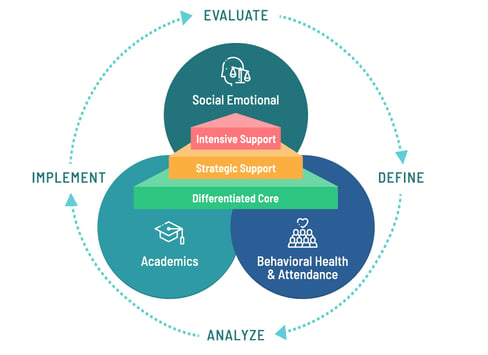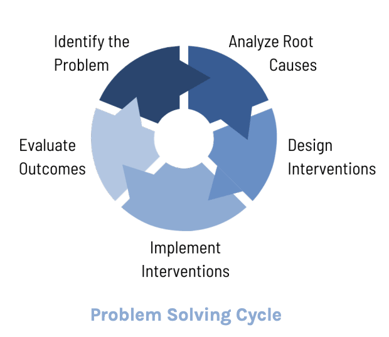A Brief History of Data-Based Decision-Making
In 2001, motivated by the desire to make US education rankings more competitive in the global climate, the G.W. Bush administration pushed through an initiative called "No Child Left Behind (NCLB)." This initiative held schools accountable for student success determined by state testing. Schools that did not make adequate yearly progress (AYP) on state exams could be penalized, placed under state supervision, and required to make significant improvements in their programming.
Alongside the birth of NCLB came Response to Intervention (RTI), a practice designed to help educators apply many teaching best practices to proactively identify and intervene on behalf of students needing additional support. Whereas state tests worked as an accountability measure to determine if students had made adequate progress for NCLB’s purpose, RTI practices pushed educators to seek out more proactive data, such as benchmark assessments (tri-annual broad outcome measures) that sampled students' mastery of grade level skills.
Using adaptive measures that adjusted the level of difficulty based on previous responses, the assessments were able to identify every student's ability level and compare them to local and national samples. These data were analyzed by school teams early in the academic year to identify students who were at the highest risk to ensure they received more and/or targeted instruction in deficit areas.
Students identified as needing intervention were then briefly assessed 1x/week or 2x/month to get small samples of their growth in a specific skill area. This "progress monitoring" was designed to help educators evaluate the quality of a student's response to the intervention they received. If students showed growth, they could graduate from needing the additional support. If students struggled to progress, teachers would use tracking graphs to determine if they should change or intensify what they were doing to support the student.
➡️ Read more about How to use progress monitoring data to guide decision-making in an MTSS practice
Where Things Went Askew...
While the intention behind this law was noble, and the merits of data-based decision-making constant, elements of it were highly unpopular and resulted in some outcomes that contradicted the spirit of data-based decision-making. For starters, many teachers became fearful of the negative consequences associated with students’ state test performance, which led to a wave of teachers and schools prioritizing “test-taking skills” and "teaching to the test," rather than applying best practices for teaching.
Moreover, many teachers grew concerned about the heavy focus on quantitative metrics to assess student performance. The argument was that students are children, not numbers, and one can not quantify their educational experience. By tying punitive accountability measures to data-based decision-making, teachers worried that schools would lose sight of the other variables impacting a student's performance (e.g,. home life, parenting, teacher relationships etc.), or social-emotional development. Data-based decision-making became seen as antithetical to knowing and supporting students as opposed to a key element of that same goal.
Businesses use sales metrics, the entertainment industry uses ticket sales, medicine uses the scientific method...why then should educators not apply objective measures to education? Ultimately, to achieve growth goals, there must be a means to evaluate where we started, where we want to end up, and how far along we’ve come to get there. At this point in the evolution of teaching and learning, there is widespread agreement that we need to consider and support the whole child. However, there is also tremendous research on how to improve student growth with evidence-based teaching and accurate data tracking. Data-based decision-making is and should be a critical part of a holistic approach.
The Evolution of Data-Based Decision Making From RTI to MTSS
As RTI gained traction, reliable data sources became more present and accessible. Teachers learned to measure all aspects of learning, from something as small as knowledge of letter sounds to even quantifying how many times a student calls out in class. Everything became measurable once we were able to think about the situation objectively (which is a challenge in education as we take what we do personally).
Soon came Positive Behavior Intervention Systems (PBIS), which uses points and rewards to measure something as great as classroom and school-wide culture. Educational software (EdTech) expanded to meet teachers' growing demand for tools to measure and quantify learning (e.g., class dojo, PBIS rewards, IXL, Xtramath, etc.).
We have also witnessed significant advancements in robust universal screeners and diagnostic and progress monitors for social-emotional competencies. As data became increasingly available, we were better able to analyze our teaching practices and identify students falling behind. As data became more universal and accessible, it became clear that data-driven decision-making worked alongside, and not counter to, educators’ ability to support student growth while still considering the other variables impacting students’ lives.
In 2015, No Child Left Behind was replaced with the Every Student Succeeds Act (ESSA), which put a more positive spin on the original concept of accountability and proactive student support. Rather than operate with a desire to avoid failure, schools were evolving to leverage data early on so they could proactively meet students' needs. As the RTI approach expanded to address areas beyond basic reading and math, a new educational framework evolved to better encapsulate the way in which schools identify and meet the full spectrum of students’ needs. Educators could make progress across academics, behavior, and SEL for all students, including English Language Learners, Gifted Learners, and Special Education students.
➡️ Read more about How to Create a Seamless Data-Driven School Culture Through MTSS
With continued accountability to help every student succeed, we’ve made tremendous advancements in the quality and availability of data and evidence-based interventions and strengthened teachers’ abilities to provide differentiated support to their students. We have also established a broader understanding that this support should span academics, behavior, and social-emotional learning. Our challenges now become how to solidify and streamline all of these components and moving parts so that this work is efficient and practicable. That process is MTSS.
What is MTSS?
Multi-Tiered System of Supports (MTSS) is a collaborative, evidence-based, approach to differentiating and personalizing instruction and intervention, across academics, social-emotional learning, and behavior for all students — so that every student can achieve academic and life success.

MTSS is one of the most effective ways to provide an equitable educational experience because it leverages collective knowledge and expertise to help teachers understand their learners' needs and make informed and strategic decisions that best support them.
MTSS begins with teachers assessing the skills of everyone in the class, to proactively identify who may need additional support in an area (e.g., reading, math, behavior). Students then receive support (research-based, targeted instruction or intervention) matched both to their skills and level of need. Those students’ progress is monitored closely to ensure that the additional support is helping. If the achievement gap has resolved, the additional support in that area is no longer required. If it does not improve, then the level of personalization increases, which includes further problem-solving to understand why each student struggles and designing a customized plan to support their needs in a defined and systematic way.

MTSS is not new. There are many academic experts and learning scientists ready to share the dos and don’ts of supporting the full spectrum of student learning needs. There are 1000s of research-backed interventions to choose from, tons of best practices to keep in mind, and so many data points to inform our data-driven decision-making. There is tremendous evidence supporting the power of an effective MTSS system to improve student outcomes for struggling learners, but there is also solidly convincing research that it improves student outcomes for ALL learners. A rising tide raises all boats.
➡️ Read more about The 7 Guiding Principles of MTSS
Interested in Learning About Branching Minds?Branching Minds is an MTSS/RTI system-level education platform that brings together innovative, easy-to-use technology with the latest insights from the learning sciences to help drive student and school success while making teachers and administrators work easier and more effective. Branching Minds connects data, systems, interventions, and stakeholders so that educators, administrators, and families can work better together to support students' holistic needs.
|
![[Guest Author] Lauren Schutz-avatar](https://www.branchingminds.com/hs-fs/hubfs/Team/IMG_0039%202.jpeg?width=82&height=82&name=IMG_0039%202.jpeg)
About the author
[Guest Author] Lauren Schutz
Lauren Schutz has been working in the field of education for over a decade as a teacher, school psychologist, executive functioning coach, and educational consultant. Lauren earned her B.A. in psychology from the University of Wisconsin-Madison and her M.A/EdS in school psychology at Tufts University. She most enjoys helping learners (child and adult) define their own goals for success, then encouraging them through the productive struggle that comes with growth. Ms. Schutz writes on a variety of education-related topics from her hometown in Chicago, IL.

Your MTSS Transformation Starts Here
Enhance your MTSS process. Book a Branching Minds demo today.
















.png?width=716&height=522&name=Qualitative%20data%20MTSS%20(preview).png)
.png?width=716&height=522&name=MTSS%20Handbook%20Blog%20(preview).png)
